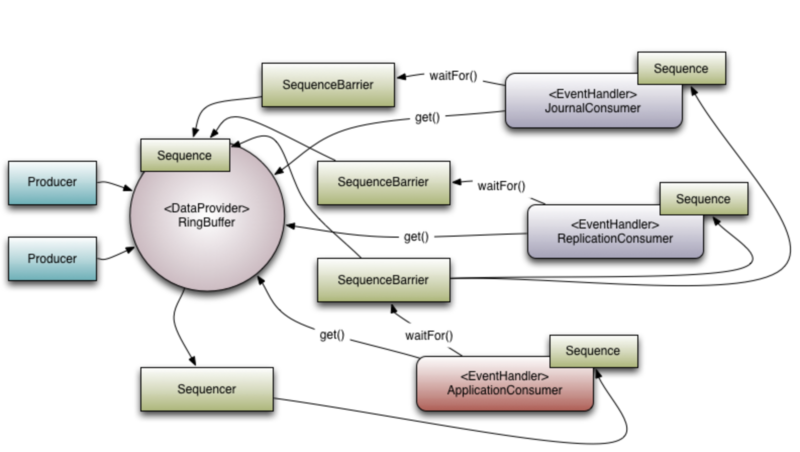Disruptor的简单介绍与应用

前言
最近工作比较忙,在工作项目中,看了很多人都自己实现了一套数据任务处理机制,个人感觉有点乱,且也方便他人的后续维护,所以想到了一种数据处理模式,即生产者、缓冲队列、消费者的模式来统一大家的实现逻辑。
下面时是对Disruptor基本使用的演示。使用中需要引入依赖
<dependency> <groupId>com.lmax</groupId> <artifactId>disruptor</artifactId> <version>3.4.2</version> </dependency>
名称解释
-
Ring Buffer
环境的缓存区,3.0版本以前被认为是Disruptor的主要成员。3.0版本以后,环形缓冲区只负责通过Disruptor的事件方式来对数据进行存储和更新。在一些高级的应用场景中,Ring Buffer可以由用户的自定义实现完全替代。
-
Sequence
Disruptor使用Sequence作为一种方法来确定特定组件的位置。每个使用者(EventProcessor)与Disruptor本身一样维护一个序列。大多数并发代码依赖于这些序列值的移动,因此序列支持AtomicLong的许多当前特性。事实上,两者之间唯一真正的区别是序列包含额外的功能,以防止序列和其他值之间的错误共享。
-
Sequencer
Sequencer是真正的核心,该接口的两个实现(单生产者, 多消费者)实现了所有用于在生产者和使用者之间的快速、正确的传递数据的并发算法。
-
Sequence Barrier
序列屏障由Sequencer产生,包含对Sequencer和任何依赖消费者的序列的引用。它包含确定是否有任何事件可供使用者处理的逻辑。
-
Wait Strategy
等待策略确定消费者将如何等待生产者产生的消息,Disruptor将消息放到事件(Event)中。
-
Event
从生产者到消费者的数据单位。不存在完全由用户定义的事件的特定代码的表示形式。
-
EventProcessor
EventProcessor持有特定消费者(Consumer)的Sequence,并提供用于调用事件处理实现的事件循环。
-
BatchEventProcessor
BatchEventProcessor它包含事件循环的有效实现,并将回调到已使用的EventHandle接口实现。
-
EventHandler
Disruptor定义的事件处理接口,由用户实现,用于处理事件,是Consumer的真正实现。
-
Producer
生产者,只是泛指调用Disruptor发布事件的用户代码,Disruptor没有定义特定接口或类型。
架构图

简单实用Disruptor
1 定义事件
事件就是通过Disruptor进行交换的数据类型。
package com.disruptor;
public class Data {
private long value;
public long getValue() {
return value;
}
public void setValue(long value) {
this.value = value;
}
}
2 定义事件工厂
事件工厂定义了如何实例化第一步中定义的事件。Disruptor通过EventFactory在RingBuffer中预创建Event的实例。
一个Event实例被用作一个数据槽,发布者发布前,先从RingBuffer获得一个Event的实例,然后往Event实例中插入数据,然后再发布到RingBuffer中,最后由Consumer获得Event实例并从中读取数据。
package com.disruptor;
import com.lmax.disruptor.EventFactory;
public class DataFactory implements EventFactory<Data> {
@Override
public Data newInstance() {
return new Data();
}
}
3 定义生产者
package com.disruptor;
import com.lmax.disruptor.RingBuffer;
import java.nio.ByteBuffer;
public class Producer {
private final RingBuffer<Data> ringBuffer;
public Producer(RingBuffer<Data> ringBuffer) {
this.ringBuffer = ringBuffer;
}
public void pushData(ByteBuffer byteBuffer) {
long sequence = ringBuffer.next();
try {
Data even = ringBuffer.get(sequence);
even.setValue(byteBuffer.getLong(0));
} finally {
ringBuffer.publish(sequence);
}
}
}
4 定义消费者
package com.disruptor;
import com.lmax.disruptor.WorkHandler;
import java.text.MessageFormat;
public class Consumer implements WorkHandler<Data> {
@Override
public void onEvent(Data data) throws Exception {
long result = data.getValue() + 1;
System.out.println(MessageFormat.format("Data process : {0} + 1 = {1}", data.getValue(), result));
}
}
5 启动Disruptor
- 测试Demo
package com.disruptor;
import com.lmax.disruptor.RingBuffer;
import com.lmax.disruptor.dsl.Disruptor;
import java.nio.ByteBuffer;
import java.util.concurrent.ThreadFactory;
public class Main {
private static final int NUMS = 10;
private static final int SUM = 1000000;
public static void main(String[] args) {
try {
Thread.sleep(10000);
} catch (InterruptedException e) {
e.printStackTrace();
}
long start = System.currentTimeMillis();
DataFactory factory = new DataFactory();
int buffersize = 1024;
Disruptor<Data> disruptor = new Disruptor<Data>(factory, buffersize, new ThreadFactory() {
@Override
public Thread newThread(Runnable r) {
return new Thread(r);
}
});
Consumer[] consumers = new Consumer[NUMS];
for (int i = 0; i < NUMS; i++) {
consumers[i] = new Consumer();
}
disruptor.handleEventsWithWorkerPool(consumers);
disruptor.start();
RingBuffer<Data> ringBuffer = disruptor.getRingBuffer();
Producer producer = new Producer(ringBuffer);
ByteBuffer bb = ByteBuffer.allocate(8);
for (long i = 0; i < SUM; i++) {
bb.putLong(0, i);
producer.pushData(bb);
System.out.println("Success producer data : " + i);
}
long end = System.currentTimeMillis();
disruptor.shutdown();
System.out.println("Total time : " + (end - start));
}
}
- 结果(部分结果展示)
Data process : 999,987 + 1 = 999,988 Success producer data : 999995 Data process : 999,990 + 1 = 999,991 Data process : 999,989 + 1 = 999,990 Data process : 999,991 + 1 = 999,992 Data process : 999,992 + 1 = 999,993 Data process : 999,993 + 1 = 999,994 Data process : 999,995 + 1 = 999,996 Success producer data : 999996 Success producer data : 999997 Success producer data : 999998 Success producer data : 999999 Data process : 999,994 + 1 = 999,995 Data process : 999,996 + 1 = 999,997 Data process : 999,997 + 1 = 999,998 Data process : 999,998 + 1 = 999,999 Data process : 999,999 + 1 = 1,000,000 Total time : 14202
由结果展示可见,边生产、边消费。
彩蛋
1 事件转换类
package com.mm.demo.disruptor.translator;
import com.lmax.disruptor.EventTranslatorOneArg;
import com.mm.demo.disruptor.entity.Data;
public class DataEventTranslator implements EventTranslatorOneArg<Data, Long> {
@Override
public void translateTo(Data event, long sequence, Long arg0) {
System.out.println(MessageFormat.format("DataEventTranslator arg0 = {0}, seq = {1}", arg0, sequence));
event.setValue(arg0);
}
}
2 消费者
2.1 消费者Demo1
消费者每次将event的结果加1。
package com.mm.demo.disruptor.handler;
import com.lmax.disruptor.EventHandler;
import com.mm.demo.disruptor.entity.Data;
import java.text.MessageFormat;
public class D1DataEventHandler implements EventHandler<Data> {
@Override
public void onEvent(Data event, long sequence, boolean endOfBatch) throws Exception {
long result = event.getValue() + 1;
Thread t = new Thread();
String name = t.getName();
System.out.println(MessageFormat.format("consumer "+name+": {0} + 1 = {1}", event.getValue(), result));
}
}
这里是使用的是EventHandler。也是使用WorkHandler,EventHandler和WorkHandler的区别是前者不需要池化,后者需要池化。
2.2 消费者Demo2
package com.mm.demo.disruptor.handler;
import com.lmax.disruptor.EventHandler;
import com.mm.demo.disruptor.entity.Data;
import java.text.MessageFormat;
public class D2DataEventHandler implements EventHandler<Data> {
@Override
public void onEvent(Data event, long sequence, boolean endOfBatch) throws Exception {
long result = event.getValue() + 2;
System.out.println(MessageFormat.format("consumer 2: {0} + 2 = {1}", event.getValue(), result));
}
}
2.3 串行依次计算
Consumer1执行完成再执行Consumer2。
package com.mm.demo.disruptor.process;
import com.lmax.disruptor.dsl.Disruptor;
import com.mm.demo.disruptor.entity.Data;
import com.mm.demo.disruptor.handler.D1DataEventHandler;
import com.mm.demo.disruptor.handler.D2DataEventHandler;
/**
* 串行依次计算
* @DateT: 2020-01-07
*/
public class Serial {
public static void serial(Disruptor<Data> disruptor) {
disruptor.handleEventsWith(new D1DataEventHandler()).then(new D2DataEventHandler());
disruptor.start();
}
}
2.4 并行实时计算
Consumer1和Consumer2同时执行。
package com.mm.demo.disruptor.process;
import com.lmax.disruptor.dsl.Disruptor;
import com.mm.demo.disruptor.entity.Data;
import com.mm.demo.disruptor.handler.D1DataEventHandler;
import com.mm.demo.disruptor.handler.D2DataEventHandler;
/**
* 并行执行
* @DateT: 2020-01-07
*/
public class Parallel {
public static void parallel(Disruptor<Data> dataDisruptor) {
dataDisruptor.handleEventsWith(new D1DataEventHandler(), new D2DataEventHandler());
dataDisruptor.start();
}
}
2.5 测试类
package com.mm.demo.disruptor;
import com.lmax.disruptor.BlockingWaitStrategy;
import com.lmax.disruptor.RingBuffer;
import com.lmax.disruptor.dsl.Disruptor;
import com.lmax.disruptor.dsl.ProducerType;
import com.mm.demo.disruptor.entity.Data;
import com.mm.demo.disruptor.handler.D1DataEventHandler;
import com.mm.demo.disruptor.process.Parallel;
import com.mm.demo.disruptor.process.Serial;
import com.mm.demo.disruptor.translator.DataEventTranslator;
import javax.swing.plaf.synth.SynthTextAreaUI;
import java.nio.ByteBuffer;
import java.util.concurrent.Executors;
import java.util.concurrent.ThreadFactory;
public class Main {
private static final int BUFFER = 1024 * 1024;
public static void main(String[] args) {
DataFactory factory = new DataFactory();
Disruptor<Data> disruptor = new Disruptor<Data>(factory, BUFFER, Executors.defaultThreadFactory(), ProducerType.MULTI, new BlockingWaitStrategy());
Serial.serial(disruptor);
// Parallel.parallel(disruptor);
RingBuffer<Data> ringBuffer = disruptor.getRingBuffer();
for (int i = 0; i < 2; i++) {
ringBuffer.publishEvent(new DataEventTranslator(), (long)i);
}
disruptor.shutdown();
}
}
总结
上边只演示了串行和并行的方式,其实还是通过组合的方式创建不的计算处理方式(需要创建多个事件处理器EventHandler)。
补充等待策略
- BlockingWaitStrategy:最低效的策略,但是对cpu的消耗是最小的,在各种不同部署环境中能提供更加一致的性能表现。
- SleepingWaitStrategy:性能和BlockingWaitStrategy差不多少,cpu消耗也类似,但是其对生产者线程的影响最小,适合用于异步处理数据的场景。
- YieldingWaitStrategy:性能是最好的,适用于低延迟的场景。在要求极高性能且事件处理线程数小于cpu处理核数时推荐使用此策略。
- BusySpinWaitStrategy:低延迟,但是对cpu资源的占用较多。
- PhasedBackoffWaitStrategy:上边几种策略的综合体,延迟大,但是占用cpu资源较少。
参考
本文参考了 Disruptor 源码以及github中的部分说明。
Demo源码地址
github
- 写作不易,转载请注明出处,喜欢的小伙伴可以关注公众号查看更多喜欢的文章。
- 联系方式:4272231@163.com
- QQ:95472323
- 微信:ffj2000












![[HBLOG]公众号](http://www.liuhaihua.cn/img/qrcode_gzh.jpg)

